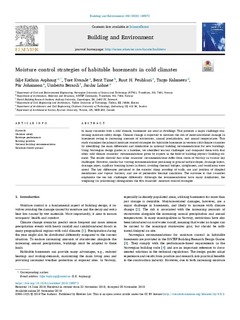Moisture control strategies of habitable basements in cold climates
| dc.contributor.author | Asphaug, Silje Kathrin | |
| dc.contributor.author | Kvande, Tore | |
| dc.contributor.author | Time, Berit | |
| dc.contributor.author | Peuhkuri, Ruut | |
| dc.contributor.author | Kalamees, Targo | |
| dc.contributor.author | Johansson, Pär | |
| dc.contributor.author | Berardi, Umberto | |
| dc.contributor.author | Lohne, Jardar | |
| dc.date.accessioned | 2020-01-27T11:40:27Z | |
| dc.date.available | 2020-01-27T11:40:27Z | |
| dc.date.created | 2020-01-07T09:29:38Z | |
| dc.date.issued | 2019 | |
| dc.identifier.issn | 0360-1323 | |
| dc.identifier.uri | http://hdl.handle.net/11250/2638047 | |
| dc.description.abstract | In many countries with a cold climate, basements are used as dwellings. This presents a major challenge concerning moisture safety design. Climate change is expected to increase the risk of moisture-related damage in basements owing to increasing amounts of stormwater, annual precipitation, and annual temperatures. This study examines the primary moisture control strategies for habitable basements in western cold climate countries by identifying the main differences and similarities in national building recommendations for new buildings. Using Norwegian design guides as a baseline, we identified ten key challenges and compared them with four other cold climate countries' recommendations given by experts in the field of building physics (building science). The results showed that other countries' recommendations differ from those of Norway in various key challenges. However, similar but varying recommendations pertaining to ground surface slopes, drainage layers, drainage pipes, capillary breaking layers in floors, avoiding thermal bridges, airtightness, and ventilation were noted. The key differences pertained to the exterior damp proofing of walls, use and position of dimpled membranes and vapour barriers, and use of permeable thermal insulation. The outcome is that countries emphasize the ten key challenges differently. Although the recommendations have many similarities, the weighting (or prioritizing) distinguishes the five countries’ moisture control strategies. | en |
| dc.language.iso | eng | nb_NO |
| dc.publisher | Elsevier | nb_NO |
| dc.rights | CC BY 4.0 | * |
| dc.rights.uri | http://creativecommons.org/licenses/by/4.0/ | * |
| dc.subject | Moisture safety | en |
| dc.subject | Envelope performance | en |
| dc.subject | Building practice | en |
| dc.subject | National building recommendation | en |
| dc.subject | Structures below ground | en |
| dc.title | Moisture control strategies of habitable basements in cold climates | en |
| dc.type | Journal article | nb_NO |
| dc.type | Peer reviewed | nb_NO |
| dc.description.version | publishedVersion | nb_NO |
| dc.rights.holder | © 2019 The authors | nb_NO |
| dc.subject.nsi | VDP::Teknologi: 500 | nb_NO |
| dc.source.volume | 169 | nb_NO |
| dc.source.journal | Building and Environment | nb_NO |
| dc.identifier.doi | 10.1016/j.buildenv.2019.106572 | |
| dc.identifier.cristin | 1767328 | |
| dc.relation.project | Norges forskningsråd: 237859 | nb_NO |
| cristin.unitcode | 7401,30,40,0 | |
| cristin.unitname | Arkitektur, byggematerialer og konstruksjoner | |
| cristin.ispublished | true | |
| cristin.fulltext | original | |
| cristin.qualitycode | 2 |
Tilhørende fil(er)
Denne innførselen finnes i følgende samling(er)
-
Publikasjoner fra CRIStin - SINTEF AS [5801]
-
SINTEF Community [2247]

